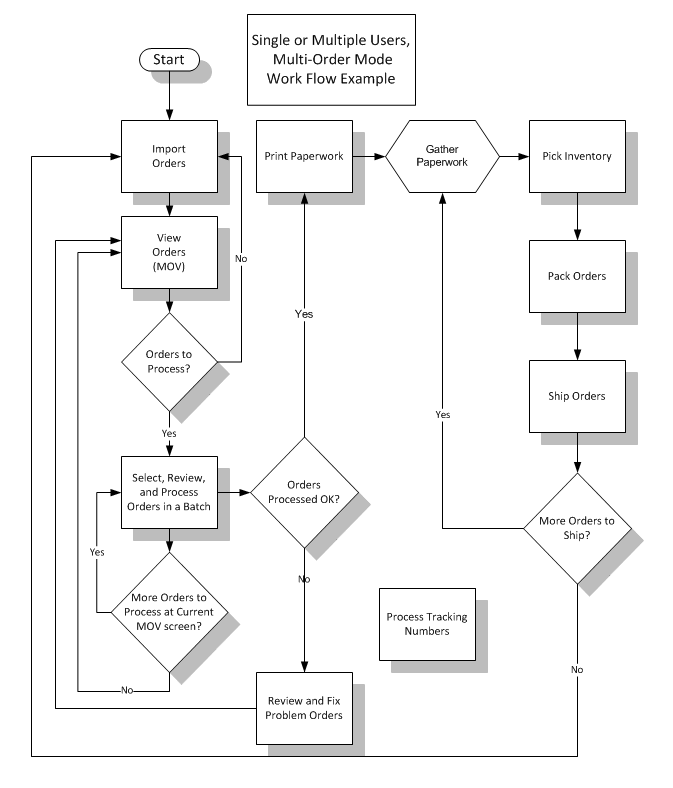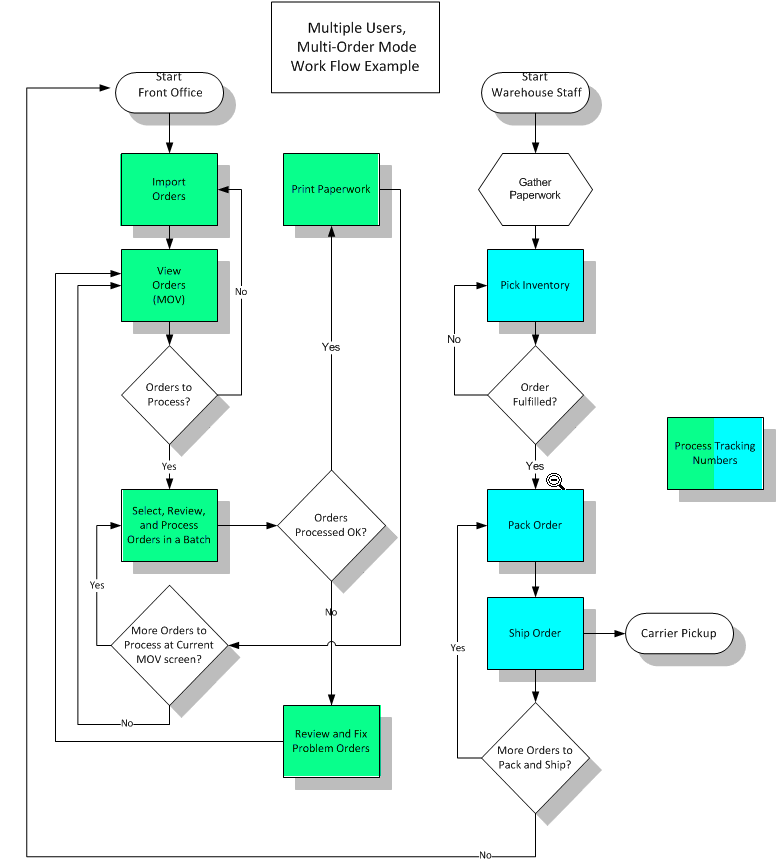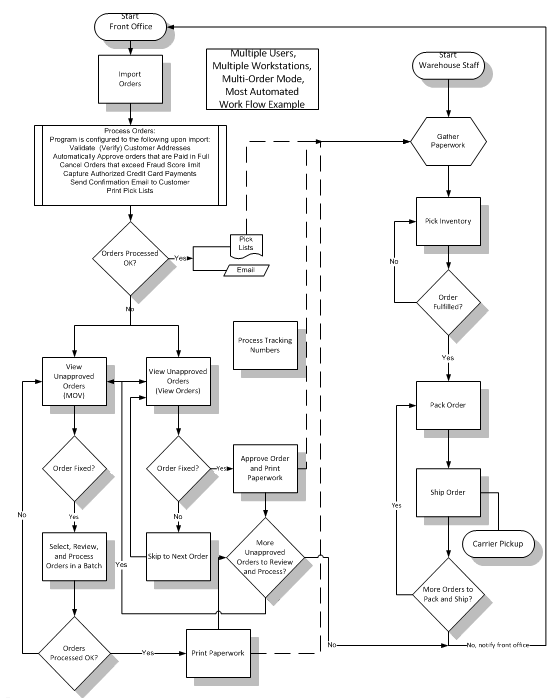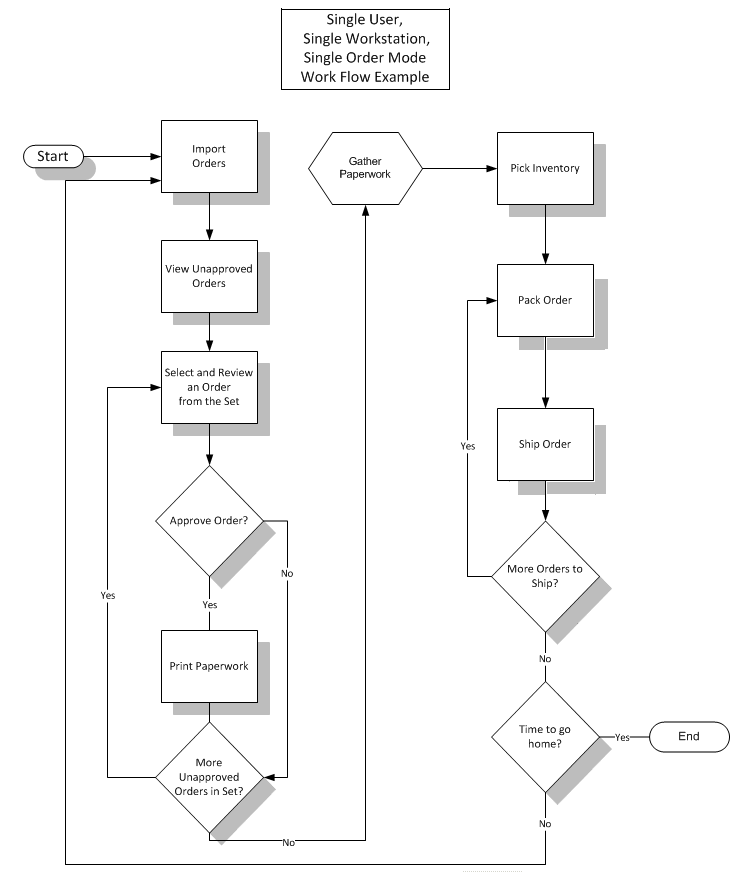Overview
The purpose of this article is to provide some guidance on the subject of “order processing’ or the basic work flow when using SEOM. The program is very flexible and can be configured to behave in many different ways, based on the setting of system parameters, so the examples outlined here may differ slightly from the way the SEOM will be used in your environment.
The examples that are outlined below assume that:
- System parameter ReviewAllOrders is set to TRUE
- System parameter CheckInventory is set to TRUE
Entering Orders into SEOM
Orders can be entered several ways:
Imported
- directly via the Internet from a SEOM-licensed shopping cart system (depends on the shopping cart, refer to the Shopping Cart Matrix)
- imported via a text file, using a properly formatted file from a SEOM-licensed shopping cart system
- imported via a text file using the Generic Import Template feature (requires a Generic Shopping Cart license from Stone Edge; other functionality requires the user to create and install an integration script according to the specifications found in the Developer’s Guide.)
Manually Entered
- order data is typed in via the Manual Orders (used for mail or telephone orders)
- order data is entered via the Point-of-Sale interface, which is used by merchants that have walk-in customers a brick an mortar store setting (requires the Plus POS or Enterprise Editions of the program)
Reviewing Orders
Orders, especially those that have been imported, should be reviewed for certain conditions before they are marked as Approved and sent to the pickers and packers. Examples of things that should be reviewed are outlined below.
Spot-check for Fraud, Accidental or Bogus orders
Orders that appear to be fraudulent should not be Approved, in fact it may be advisable to Cancel and possibly Delete those orders.
Identify Potentially Fraudulent Orders
- use the Validate button next to the Bill To and Ship To address fields found on the Customer tab of the Process Orders screen
- check the Address Verification Response (AVS) from the credit card gateway, or the CVV and CVV2 codes, all of which can be seen in the Existing Transactions section of the Payment tab of the Process Orders screen
- merchants should carefully review orders that originate in locations known for a high rate of fraud and also be on the lookout for suspicious email addresses; to facilitate the identification of fraudulent orders, obtain a subscription to MaxMind Fraud Prevention services and view an order’s Fraud Score on the Customer tab of the Process Orders screen
Check the Availability of Inventory Items
Orders containing items that are out of stock are potential candidates to remain temporarily Unapproved. Consider the following:
A customer wants two widgets and SEOM shows 2 Qty, 1 Shipped, 1 BO, 0 On Hand on the Process Orders screen. Why is this important and what does it mean? By looking at the Shipped, BO and On Hand columns, the merchant can see that one widget has been allocated (Shipped) to the order, but there are no more left in stock to complete the order. Therefore, the program determines that an additional unit must be backordered (BO).
The merchant has the choice of shipping the single available widget now (partial shipment) or waiting until more widgets have been received from the supplier so that both widgets can be shipped to the customer at the same time (complete shipment).
If the merchant chooses not to ship the partial order, he can return the allocated widget to inventory by clicking the Force button, which will alter the value in the Shipped column to 0 and the BO column to 2. Do not Approve this order until the shipment of widgets arrive from the supplier, and are received into the SEOM inventory. At that time, the merchant can then Fill the order that was waiting for two widgets and mark it as Approved. If he has another order that reflects a backorder for a single widget, he can then use the widget that was previously returned to inventory to fill this request by clicking the Fill button.
If the merchant chooses to ship the one available widget and Approves the order, the program will still know to backorder the additional widget, which will be processed (filled) in a new or subsequent order placed by the same customer when the widget becomes available.
Send Drop-Ship Purchase Orders
Drop-shipping is name given to the practice of shipping products directly from a supplier rather than from the merchant’s in-house inventory. If there is a drop-ship item in the order, the WARNING tab appears at the bottom of the accordion. If this practice will never be employed, skip this section.
Before marking an order as Approved, check the Process Orders > Shipping > Drop-Shipments tab or click the WARNING tab and select Drop-Ships. Create and send the drop-ship purchase order to the supplier from either of these locations.
When system parameter DropShipCheckQOH is set to TRUE, the program prompts you to decide if the order should be filled from existing stock rather than as a drop-ship order. This parameter was introduced in V5.929.
Collect or Confirm Payment
Some merchants capture payment for orders at the shopping cart, while others may choose to perform that function via SEOM. In either case, it is a good practice to review the payment status of an order before Approving it.
If traditional PayPal accounts or traditional checks are used to pay for the order, confirm that the funds have been received prior to Approving the order.
If SEOM is used to perform real-time authorization and capture of credit card payments, eChecks, or debit card transactions, click on the Payment tab of the Process Orders screen. This is also the place to process other online transactions or record payment information, including the logging of Purchase Order terms, Cash and C.O.D payments.
Check for Special Instructions
Some shopping cart systems allow the customer to enter special order instructions or gift messages with the order. The merchant can also record internal comments or notes when placing or reviewing an order.
When there is data in these fields, the WARNING tab appears at the bottom of the accordion. The information in these fields can be seen either by selecting WARNING > Comments & Instructions tab or Process Orders > Orders > Comments & Instructions.
Approving Orders
Approving an order in SEOM terms basically means that the order has been reviewed to rule out fraud, full payment has been received, the items are in stock and the order can be packed and shipped. In the case of orders containing items that are drop-shipped from a supplier rather than filled from stock, approving an order implies that a drop-ship purchase order has been created and sent to the supplier.
If any of the conditions mentioned in the previous paragraph are not satisfied, it is acceptable for the order to remain unapproved until such time as they are satisfied.
The program provides system parameters that allow your to automatically mark manually-placed orders and POS orders as Approved, which in most cases can be a safe assumption since the order is created by a staff member rather than an invisible customer, as is the case with imported orders.
It is also possible to automatically approve orders upon import by using the Approval Rules feature, however, it is recommended that you manually review all orders until they have become very familiar with the program. At that point in time, using Approval Rules and the Multi-Order Processor can greatly increase the number of orders that can be processed in a day.
To manually approve an order, click Approve on the Process Orders screen. When you are comfortable with the program you might want to start using the Multi-Order Processor to process orders in batch mode.
Printing Paperwork
In SEOM terminology, paperwork refers to the reports that are printed when orders are processed. There are several categories of order-related reports, one of which can be printed when an order is imported, while others can be added to a batch print queue or printed on an order by order basis. The order paperwork categories are:
- Sales Receipts, also commonly known as Invoices
- Packing Slips
- Pick Lists – which can be printed at import
- Mailing Labels
- Shipping Labels
- Credit Slips
Standard reports are provided with the program, many of which also various formats or templates, which provide different kinds of data. You or a third party can also create custom reports for situations that are not covered by the standard reports.
System parameters are used to store the user’s report template preference and the number of copies of each that should be printed.
When an order is approved by clicking Approve on the Process Orders screen, you have the opportunity to print the paperwork immediately, print it later (add it to the batch printing queue) or choose not to print any of the paperwork at that time. It is possible to print the paperwork at a later time by clicking Print on the Process Orders screen or when using one of the Packing screens that is also able to print order paperwork.
Packing Orders
There are three possible screens to use for packing orders with SEOM, the Pack Orders screen, the Pack & Ship screen and the QuickShip screen. The Packing screen is very limited in its capabilities, while the Pack & Ship and Quickship screens are able to print order paperwork, including shipping labels if one of the integrated shipping software solutions has been configured (UPS Online Tools, ShipRush for FedEx or Endicia DAZzle for USPS). Refer to the Store Setup Wizard, Shipping section for more information. Tracking numbers obtained from any of these applications are immediately recorded in the SEOM tables. It is also possible to use an external shipping system, such as UPS WorldShip, by means of an ODBC connectionto the SEOM store data file.
Order Processing Work Flow Examples
Single Order Mode
This is the recommended method to follow until you have become very well acquainted with the program and its features. The Process Orders screen is where you can review all or a subset of orders, and perform a variety of actions related to those orders, before or after they have been Approved for shipping.
While the program offers great flexibility in the sequence in which the user may perform the actions that are available at the Process Orders screen, it is imperative that a shipping label is not printed via the Print Shipping Label button on the Shipping tab of the Process Orders screen prior to the order being marked as Approved, Doing so causes the accounting data in SEOM to be inaccurate.
The following flowchart depicts the most simplistic sequence of events when processing orders in Single Order Mode. It assumes that this is a very small operation ( less than 50 orders per day) and all of the steps are being performed by a single individual, at a single workstation, processing a single order at a time. Orders are being manually reviewed at the Process Orders screen with the All Pending (not approved yet)Quick Filterapplied, to produce a set of order records that have not yet been approved and processed. When the work flow process has been completed for all of the orders in the currently viewed set, the entire process can be repeated any number of times until the end of the business day.
If the program is configured to send order status updates and tracking emails to customers, and if new tracking data is available, that function is performed by the Process Tracking Numbers link found at Main Menu > Settings > Shipping Functions at any given time throughout the day. If no new tracking data is present, the program displays a message to that effect. This procedure is not represented in the flowchart below.
Figure 1: Single Order Processing Mode
Refer to Knowledge Base Topic, Work Flow Scenarios, User Scenario One for a more detailed step-by-step example.
Multi-Order Mode
This method is for more experienced users of the program, which allows orders to be processed in a batch, rather than one by one. The Multi-Order Processor screen is where batch processing of orders takes place. Just as with the Process Orders screen, the user can use a Quick Filter or other controls to create a list of orders to be processed. Once that list is populated on the screen, it is also possible to select only a few of those orders to process.
You control which orders will be affected and which processes will be performed against the chosen orders by making on-screen selections. Multiple actions can be performed in the same batch processing cycle. For example, the list may contain 10 orders but we may only want to choose five of those orders to be processed in a batch cycle. All five orders will be approved, but perhaps only three of those five orders are selected to capture payment for the order.
In addition to selecting the orders, approving the orders, and capturing payments, you can tell the program to create any drop-ship purchase orders that are needed, send the customers a confirmation email, and add the paperwork (invoice or packing slips) to the batch print queue. Go to the Process Orders tab of the Multi-Order Processor and click Process Orders to start the batch processing cycle. When the current processing cycle is completed, the orders which were processed in that cycle may no longer be visible, if they no longer match the selection criteria that produced the list of orders.
Using the Multi-Order Processor and adding the paperwork to the batch print queue avoids the possibility of that the shipping label is printed prior to the order being Approved.
Notice that the Process Tracking Numbers procedure is not directly connected to the rest of the work flow. The reason behind this is that Process Tracking Numbers can only be run after new tracking data is present in SEOM, and it can be run multiple times throughout the day. It does not need to be run at any precise point in the work flow, although the pack and ship steps must have been completed at least once before it can run; therefore, it is not directly connected to the other steps in the flow chart. This procedure also assumes that the program has been configured to send order status updates to the Web and tracking emails to customers. To execute the procedure, click Process Tracking Numbers found at Main Menu > Settings > Shipping Functions at any given time throughout the day. If no new tracking data is present, the program displays a message to that effect.
Example 2: Single or Multiple Users, Multi Order Processing Mode

Figure 2: Multi-Order Processing Mode – Single or Multiple Users
Example 3: Multiple Users, Multiple Workstations, Multi Order Processing Mode

Figure 3: Multi-Order Processing Mode – Multiple Users, Multiple Workstations
-
Processes in green represent tasks performed by front office staff and those in blue represent tasks normally performed by warehouse staff
Example 4: Multiple Users/Workstations in each Department, Multi Order Processing Mode with Automation

- The dotted lines indicate the flow of work from the front office staff to the warehouse staff

